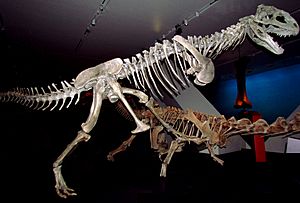Majungasaurus facts for kids
Quick facts for kids Majungasaurus |
|
|---|---|
 |
|
| Skeleton cast on display at the Royal Ontario Museum. | |
| Scientific classification | |
| Genus: |
Majungasaurus
|
| Species: |
crenatissimus
|
| Synonyms | |
|
Megalosaurus crenatissimus |
|
Majungasaurus (which means "Mahajanga lizard") was a medium-sized theropod dinosaur. It lived in Madagascar during the Late Cretaceous Period, about 70 to 66 million years ago. This dinosaur was a fierce hunter and is related to the more famous Carnotaurus.
Contents
Meet Majungasaurus!
Majungasaurus was a powerful meat-eating dinosaur. It walked on two strong legs and had short arms. Scientists believe it grew to be about 20 to 23 feet (6 to 7 meters) long. That's roughly the size of a small bus! It weighed around 2,400 pounds (1,100 kilograms).
Where and When Did It Live?
Majungasaurus lived on the island of Madagascar, off the coast of Africa. This was during the very end of the dinosaur age, the Late Cretaceous Period. At that time, Madagascar was already an island, just like it is today. This means Majungasaurus evolved in a unique environment.
All Majungasaurus fossils have been found in the Mahajanga Province of Madagascar. Most were found within 30 miles (50 kilometers) southeast of the capital city, Mahajanga.
What Did Majungasaurus Look Like?
Majungasaurus had a very distinctive look. Its most famous feature was a single, rounded horn-like bump on top of its head. This bump was made of bone. Scientists aren't sure exactly what it was for. It might have been used for showing off to other dinosaurs. Or perhaps it was used for head-butting during fights.
Its skull was quite short and tall. It had many sharp, serrated teeth, perfect for tearing meat. The skin of Majungasaurus was also special. Fossil evidence shows it had rough, bony scales called osteoderms. These were similar to the scales found on crocodiles or some lizards. This gave it a tough, armored appearance.
What Did It Eat?
Majungasaurus was a carnivore, meaning it ate meat. It was likely one of the top predators in its environment. It probably hunted large plant-eating dinosaurs like Rapetosaurus. Scientists have found Majungasaurus teeth marks on the bones of Rapetosaurus. This shows it was a powerful hunter.
Interestingly, scientists have also found bite marks on Majungasaurus bones that match Majungasaurus teeth! This suggests that sometimes, these dinosaurs might have eaten other Majungasaurus. This could have happened if food was scarce, or if they were scavenging on dead animals, even their own kind.
How Do We Know About Majungasaurus?
The first bones of Majungasaurus were found in Madagascar in 1896. These early finds were just a few teeth and bones. At first, scientists thought they belonged to a different dinosaur called Megalosaurus.
Later, in 1955, more complete fossils were discovered. This led to the official naming of Majungasaurus. Even more exciting discoveries happened in the 1990s. Scientists found a nearly complete skull and many other bones. These new finds helped us learn a lot more about this amazing dinosaur.
One interesting discovery was a skull bone that was first thought to be from a different type of dinosaur called a pachycephalosaur. These dinosaurs are known for their thick, dome-shaped skulls. However, later research showed that this bone was actually the unique horn from the top of a Majungasaurus skull.
Scientists also study the bones of Majungasaurus to learn how it breathed. They've found evidence of air sacs in its bones, similar to those found in modern birds. This suggests that Majungasaurus had a very efficient way of breathing, helping it to be an active predator.
Images for kids










